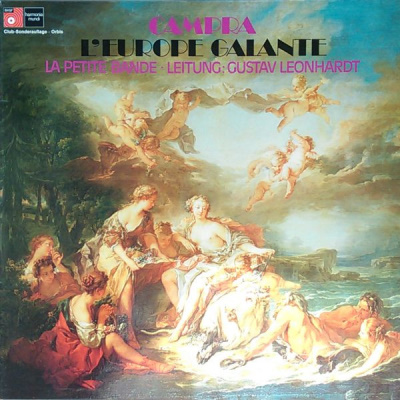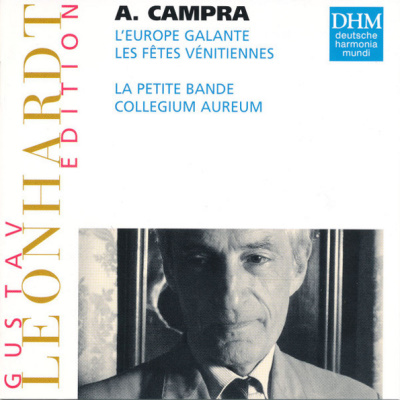 |
|
1 LP -
25 21954-2 - (p) 1973
|
 |
| 1 CD -
74321 32332 2 - (c) 1995 |
|
L'EUROPE
GALANTE - Ballet représenté en l'an
1697. Paroles de Monsieur de La Motte
|
|
|
|
|
|
|
|
| André CAMPRA (1660-1744) |
PROLOGUE
|
|
|
|
|
- Ouverture
|
|
4' 15" |
A1 |
|
- Air · La
Discorde et Vénus: "Quelle
soudaine horreur"
|
|
6' 51" |
A2 |
|
LA
FRANCE
|
|
|
|
|
- Air ·
Cephise: "Paisibles lieux"
(André Destouches)
|
|
2' 39" |
A3 |
|
- Air · Un Berger: "Soûpirons
tous" |
|
3' 32" |
A4 |
|
-
Passepied I et II
|
|
2' 23" |
A5 |
|
L'ESPAGNE |
|
|
|
|
- Air · Dom Pedro: "Sommeil" |
|
6' 17" |
A6 |
|
- Premier
Air pour les Espagnols
(Loure)
|
|
2' 07" |
B1 |
|
- Air: "El
esperar en amor"
|
|
2' 35" |
B2 |
|
-
Seconde Air · Rondeau
|
|
1' 33" |
B3 |
|
L'ITALIE |
|
|
|
|
- Air pour
les Masques
|
|
1' 13" |
B4 |
|
- Air
italien: "Ad un cuore tutto
geloso"
|
|
3' 51" |
B5 |
|
- La Forlana
|
|
1' 17" |
B6 |
|
-
Menuet |
|
1' 18" |
B7 |
|
LA
TURQUIE
|
|
|
|
|
-
Air · Zaïde: "Mes yeux" (André
Destouches)
|
|
3' 54" |
B8 |
|
-
Passacaille
|
|
3' 34" |
B9 |
|
- Air · La
Discorde et Vénus: "C'en est
fait"
|
|
2' 16" |
B10 |
|
|
|
|
|
Rachel YAKAR,
Sopran (La Discorde, Céphise, Une
Espagnole)
Marjanne KWEKSILBER, Sopran
(Vénus, Zaïde, Une Femme
Espagnole)
René JACOBS, Countertenor
|
LA PETITE BANDE
/ Sigiswald Kuijken, Konzertmeister
/ Gustav LEONHARDT, Leitung
- Bruce Haynes, Ku Ebbinghe,
Barthold Kuijken, Oswald van Olmen,
Blockflöte
- Bruce Haynes, Pol Dombrecht, Ku
Ebbinghe, Pieter Dhont, Barockoboe
- Hansjürg Lange, Claude Wassmer, Barockfagott
- Sigiswald Kuijken, Lucy van Dael,
Janine Rubinlicht, Dirk Verelst, Jan
Reichow, Gilbert Bezzina, Violine
- Laura Jeppeson, Marten Boeken,
Janneke van der Meer, Ruth
Hesseling, Wiel Peeters, Martin
Sonneweld, Viola
- Wieland Kuijken, Viola da
gamba
- Wieland Kuijken, Violoncello
- Anner Bylsma, Jordi Savall, Richte
van der Meer, Basse de Violon
- Bob van Asperen, Cembalo
|
|
|
|
|
|
Luogo
e data di registrazione |
|
Schloß Amerongen
(Holland) - 1973
|
|
|
Registrazione:
live / studio |
|
studio |
|
|
Recording
Supervision |
|
Dr. Thomas Gallia
|
|
|
Engineer |
|
Sonart
|
|
|
Prima Edizione
LP |
|
Harmonia Mundi (Basf)
| 25 21954-2 | 1 LP - durata 49'
35" | (p) 1973
|
|
|
Edizione CD |
|
Deutsche
Harmonia Mundi | LC 00761 |
74321 32332 2 | 1 CD -
durata 77' 38" | (c) 1995 |
ADD |
|
|
Cover Art
|
|
"Die Entführung der
Europa" - mit freundlicher
Genehmigung von: Giraudon, Paris
|
|
|
Note |
|
- |
|
|
|
|
|
A few years
after his arrival in Paris
in 1694, André Campra
was able to take over as
Lully's successor in the
field of ballet and opera.
He did so, it is true, with
a certain reserve, for the
published his first
ballet-opera anonymously,
but it was precisely this Europe
galante which brought
him the necessary success.
He continued Lully's style
and thus remained completely
traditional in the form of
the ballets as in the
instrumentation of the
music. His personal accent
lies more in the liveliness
of his dances and in the
legance of the sung airs.
A pupil and friend of Campra
was André Cardinal
Destouches. The three
airs which he - also
anonymously - contributed to
L'Europe galante are
among the most deeply felt
and demanding in the whole
work. Two of them appear in
our recording.
The title itself, "L'Europe
galante", indicates that
such a ballet can have no
dramatic action. It consists
rather of "galant"
impressions with apparent
fragments of action, which
determine the entire text,
"galant" conversations
playing with thoughts and
formulations.
The courtly dance was
geometrically ordered, in
artistic and, even in rapid
movments, in controlled
steps. Sung speech was
similarly subject to the
metrical rules of poetry.
For French art, an "ordered"
harmony remained important,
as far as buildings and
landscape gardening were
concerned as well as in
music.
|
  |
|
|